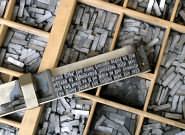The Best Resume Fonts
Our Best Resume Fonts List is a simple guide showing which resume fonts to use and why you should use them. How to pick easy to read fonts and use them to format the page so it gets read quickly.
 Our resume fonts guide will help you choose which fonts can be used to help fill in the page when you are light on content.
Alternatively, in the opposite situation, if you have too much content, you will want to choose a font that will let more information fit on the page.
You can also select resume fonts that give you extra white space on the page they will spread out your information so it won't look all smashed together.
Our resume fonts guide will help you choose which fonts can be used to help fill in the page when you are light on content.
Alternatively, in the opposite situation, if you have too much content, you will want to choose a font that will let more information fit on the page.
You can also select resume fonts that give you extra white space on the page they will spread out your information so it won't look all smashed together.
Below we have listed several scenarios that you may encounter when writing your resume. Common scenarios such as too many words, not enough words or not enough white space. The information in this guide can be used to help you when you are using our Free Resume Creator when writing the objectives, skills, description, and additions sections. These are places where you are meant to list or describe your attributes in detail. This guide will help if you are writing it by hand too.
 Our resume fonts guide will help you choose which fonts can be used to help fill in the page when you are light on content.
Alternatively, in the opposite situation, if you have too much content, you will want to choose a font that will let more information fit on the page.
You can also select resume fonts that give you extra white space on the page they will spread out your information so it won't look all smashed together.
Our resume fonts guide will help you choose which fonts can be used to help fill in the page when you are light on content.
Alternatively, in the opposite situation, if you have too much content, you will want to choose a font that will let more information fit on the page.
You can also select resume fonts that give you extra white space on the page they will spread out your information so it won't look all smashed together.
Below we have listed several scenarios that you may encounter when writing your resume. Common scenarios such as too many words, not enough words or not enough white space. The information in this guide can be used to help you when you are using our Free Resume Creator when writing the objectives, skills, description, and additions sections. These are places where you are meant to list or describe your attributes in detail. This guide will help if you are writing it by hand too.
Career Help Center
Resume Fonts for Better Readability
- General Guidelines
The employer will be looking at a stack of resumes, so they will quickly scan through your information. You want to do what you can so they can glean as much information as possible. The employer will be looking for particular keywords, and you want them to stand out. Use the suggestions on this page for your cover letter, reference page, and other documents we offer. You will generally want to use easy to read resume fonts like these:- Arial
- Courier New
- Helvetica
- Tahoma
- Times New Roman
- Verdana
- Not Enough Information
If you have a limited employment history or education history the result can be a sparsely populated resume. You will want to do what you can to make it look more populated without adding bloat or filler. A resume like this can use monospaced resume fonts such as Courier. It could also use a wider spaced resume fonts such as Verdana, Tahoma, or Georgia. You can also use a larger font size. - Too Much Information
If your resume contains too much information, you can compensate for that in two ways. One way is to use a more compact resume font like Arial, for example. Another is to use a smaller font size while being careful not to make it so small that it will be hard to read. Of course, you should also edit out unnecessary items from your resume to keep the important stuff and remove the fluff. - Other Fonts
Although appropriate in some industries be careful when using fonts such as Impact, Comic Sans MS, and others. Fancy typefaces with outlines, scripts, and shadows should be avoided. These would not be appropriate for most positions, but we provide these examples for situations where they could be. - White Space
White space is the part of the page that contains no words and is blank. You want to include white space between each section so your information won't look all smashed together. White space makes it easier to read and is more comfortable to the eyes. It also makes it easier to glean the information from the resume in short-order, giving you the best chance of getting an interview.